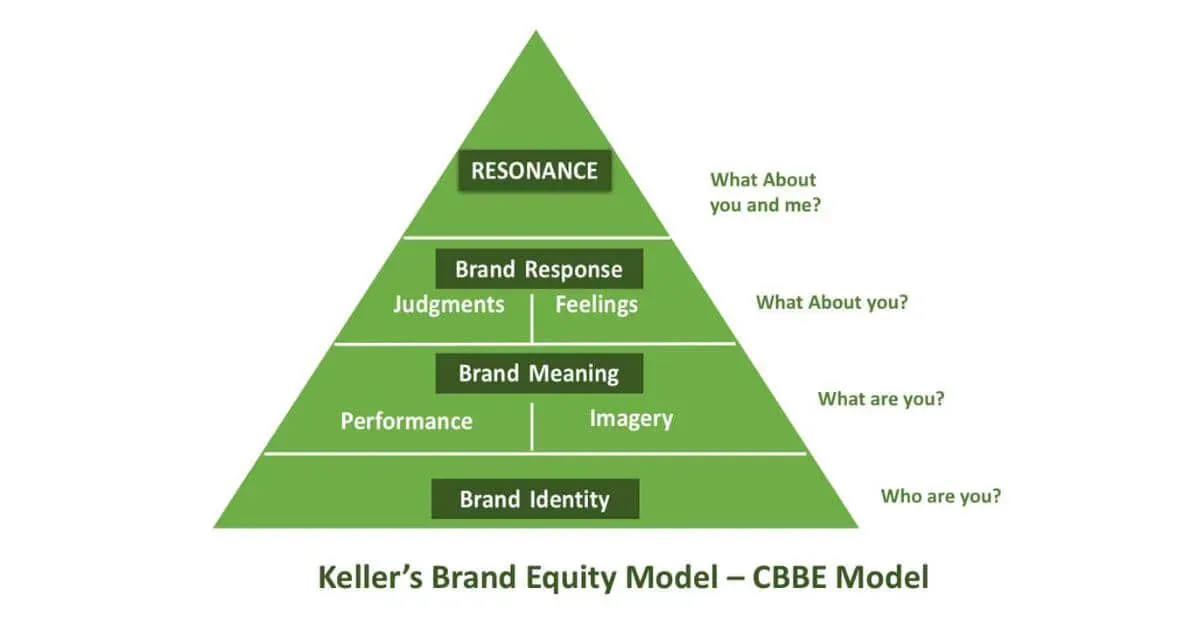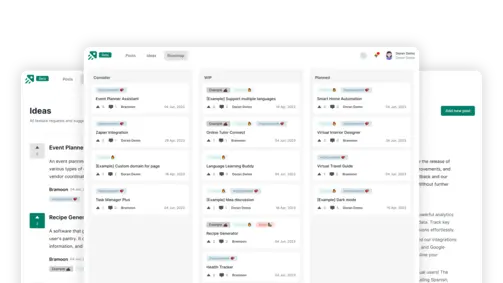Customer-Based Brand Equity Framework: Key Elements
Create changelog and product roadmap for your product
Explore nowTable of contents 9 min
- Customer-based Brand Equity (CBBE): What is it?
- Why is the Customer-Based Brand Equity Framework important?
- Customer-based Brand Equity Framework: The Brand Equity Model developed by Keller
- What precisely is the Pyramid of Customer-based Brand Equity?
- The Operation of Keller’s CBBE Pyramid’s Four Levels of Customer-based Brand Equity Framework
- Other Frameworks for expanding your Business
In today’s competitive market, building a strong brand goes beyond logos and taglines. It’s about how customers perceive and connect with the brand on an emotional and cognitive level. The Customer-Based Brand Equity Framework (CBBE), developed by renowned marketing expert Kevin Lane Keller, offers businesses a powerful model to understand, measure, and enhance their brand’s value from the customer’s perspective. This article looks into the key elements of the CBBE framework and explores why it’s essential for building sustainable brand equity.
Customer-based Brand Equity (CBBE): What is it?
Apple Inc. Coca-Cola, Porsche. -What is your reaction to encountering the names of these brands? These entities generate emotional responses, ideally positive as intended by their marketing teams, and serve as examples of robust brands that possess significant brand equity.
CBBE represents the value of a brand, determined by customer perceptions and sentiments associated with it. Brand equity has historically been established through recommendations made via word of mouth. Social media, online advertising, and customer experience have improved the capability to engage customers on a more personal and emotional level, facilitating the development of relationships with them. Ensuring that customers maintain positive perceptions, feelings, thoughts, and experiences related to your brand is crucial.
Why is the Customer-Based Brand Equity Framework important?
The Customer-Based Brand Equity (CBBE) Framework is crucial because it provides a structured approach for building and managing a brand by focusing on how consumers perceive it. The framework emphasizes that a brand’s value is ultimately determined by customers’ thoughts, feelings, and experiences with the brand. This focus on customer perception allows businesses to create more meaningful and long-lasting connections with their audience.
One of the key reasons for its importance is that it helps brands differentiate themselves in crowded markets. By understanding how customers view a brand’s unique attributes, companies can tailor their marketing strategies to strengthen these qualities, building customer loyalty and increasing the likelihood of repeat business.
Additionally, the CBBE framework highlights the emotional and psychological factors that influence customer decisions. When a brand is successful in creating positive emotional associations, it can inspire strong customer loyalty and advocacy, leading to higher market share and profitability.
In a digital age where consumer choices are vast and competition is fierce, a strong, customer-centric brand foundation helps businesses stay relevant, adapt to changing preferences, and ultimately drive long-term success.
Customer-based Brand Equity Framework: The Brand Equity Model developed by Keller

Due to the complexity and nuanced nature of brand equity, it is advisable to approach it in measurable stages through the use of a customer-based brand equity framework. The most recognised CBBE model is the Keller Model, developed by Professor of Marketing Kevin Lane Keller and first presented in his influential work, Strategic Brand Management.
The Keller customer-based brand equity framework is structured in a pyramid format, illustrating the process for businesses to develop from a solid foundation of brand identity to the ultimate goal of brand equity, referred to as ‘resonance.’ This stage represents a scenario in which customers maintain a sufficiently positive relationship with a brand, enabling them to act as advocates for it.
What precisely is the Pyramid of Customer-based Brand Equity?

Each stage of the pyramid of customer-based brand equity framework is dependent on the successful completion of the preceding stage, making it essential to solidify each step prior to advancing to the subsequent levels. Each interaction throughout a customer’s journey with your brand should result in favourable thoughts, emotions, and perceptions.
Achieving resonance allows a brand to identify and leverage customer loyalties and attitudes, regardless of whether they are favourable or unfavourable. Understanding negative experiences allows a brand to gain insights into customer perceptions of their product, enabling the transformation of these experiences into positive outcomes.
Dividing CBBE into Keller’s four levels of customer-based brand equity framework enables marketers to gain insights into customer desires and needs prior to the purchase decision, or potentially even before the customers themselves recognise those desires.
The iPad exemplifies the principles of customer-based brand equity (CBBE). Built upon the strong foundation of Apple’s brand identity, the iPad was designed to be visually appealing, user-friendly, and capable of fulfilling a wide range of customer needs and expectations. The product received positive feedback from customers, and any issues that resulted in negative reactions were promptly addressed through patches.
In a short period, iPad users began to highlight its advantages and demonstrate their brand loyalty. The iPad has since become a common presence in retail environments, healthcare facilities, educational institutions, workplaces, and residential settings. This situation exemplifies a scenario where a previously unrecognised need or desire became apparent upon encountering the object in question. It has become indispensable.
The Operation of Keller’s CBBE Pyramid’s Four Levels of Customer-based Brand Equity Framework

Level 1: Brand Identity (Who are you?)
We can incorporate the question: ‘and what distinguishes you from others?’ This is the perspective customers have regarding your brand and how they differentiate it from competitors. This level is critical and must possess sufficient strength to support the structure above it effectively. The function serves two primary purposes:
-
To determine your unique selling point within the marketplace
-
To inform customers about your identity
This analysis examines the terminology and visuals that consumers connect with a specific brand name. Brand identity measures the extent and depth of customer recognition and understanding of a brand.
Level 2: Brand Meaning (What are you?)
Upon gaining awareness of your brand, customers will seek additional information regarding your product. Consumers will evaluate its features, aesthetics, design, reliability, durability, customer experience, and overall value to ascertain its brand significance. Delivering quality and reliability consistently is essential for fostering positive brand associations in customers’ minds. To enhance brand reputation, Level 2 is divided into two distinct categories:
-
Brand performance (rational): This has the potential to either enhance or undermine a brand. The document addresses aspects of product functionality, reliability, durability, pricing, and customer service, along with customer satisfaction metrics. The product operates as advertised, and when it functions effectively, customer feedback is likely to be favourable.
-
Brand imagery (emotional) in nature, serves distinct yet equally significant purposes by addressing the social and psychological needs of customers. How is the brand perceived by customers? Volvo presents an image of Scandinavian elegance, emphasising family values, safety, and environmental responsibility. In contrast, Cushelle conveys a sense of softness, comfort, and homeliness.
Find out more: 10+ Customer Satisfaction Metrics for Business Success
Level 3: Brand Response (What are the feelings for the brand?)
At this stage of Keller’s model of customer-based brand equity framework, distinguishing between judgement and feelings can be challenging, as they are deeply personal for each individual customer.
One customer may assess the brand as irrelevant, while another may consider it entirely relevant.
Another individual may conduct their own value comparison against an alternative product, either critically or objectively.
The inclusion of actual interactions alongside perceived reputation complicates the quantification of customer sentiment towards a brand and the level of trust they place in it.
Level 4: Brand Resonance (a strong relationship)
The pinnacle of Keller’s customer-based brand equity framework is resonance, which occurs when a customer is:
-
Committed to a specific brand
-
Regarded as superior
-
Will not purchase any alternative.
-
Participation in a brand community is possible through avenues such as social media groups or clubs.
-
Promotes its advantages to others
Several factors influence customer perception: overall experience, quality of customer service, product offerings, and perceived value. The Net Promoter Score serves as an effective metric for resonance, posing a straightforward enquiry: “How likely is it that you would recommend [Product X] to a friend or colleague?”.
Read more: How to Calculate NPS & What does NPS Stand for
Other Frameworks for expanding your Business
In addition to the Customer-Based Brand Equity (CBBE) Framework, which focuses on building customer loyalty and perceptions of brand value, the following models can enhance your approach to brand equity and positioning:
Aaker’s Brand Equity Model
David Aaker’s model identifies five key components of brand equity:
-
Brand Loyalty
-
Brand Awareness
-
Perceived Quality
-
Brand Associations
-
Other Proprietary Assets
Aaker’s model helps companies build strong brand equity by focusing on these elements, which directly influence customers’ willingness to pay premium prices, trust the brand, and recommend it to others. It’s particularly effective for enhancing a company’s brand positioning strategy.
Read more: What Is the Aaker Brand Equity Model? Definition and Components
Brand Positioning Bull’s-Eye
Developed by Kevin Lane Keller, this framework helps businesses define their brand positioning by considering key elements such as:
-
Points of Parity (PoPs): Elements where your brand is on par with competitors.
-
Points of Difference (PoDs): Unique attributes that set your brand apart. This model focuses on aligning brand attributes with customer expectations, which improves the perception of brand value and ensures the brand occupies a distinct and competitive position in the market.
Read more: Understanding and Implementing Brand Positioning Models
The Customer-Based Brand Equity Framework serves as a roadmap for businesses striving to build meaningful, customer-driven brands. By understanding how customers perceive a brand and strategically enhancing brand awareness, associations, and loyalty, companies can foster a deeper connection with their audience. In a marketplace where consumer preferences and trends constantly shift, the CBBE framework offers a customer-centric approach that helps brands maintain relevance, grow stronger relationships, and achieve long-term success.
What to not miss out on our blog
Gain insightful knowledge and invaluable experiences from dedicated experts.

CRM System Explained: Benefits, Types, and How It Works
Discover everything about CRM system. Learn the benefits and how a CRM system works to improve customer relationships and streamline business operations.

Are you ready? Start your free trial today.
Enhance communication, keep track of the progress, understand customers' insight and more by taking your first trial on Doran.
Sign up for free

